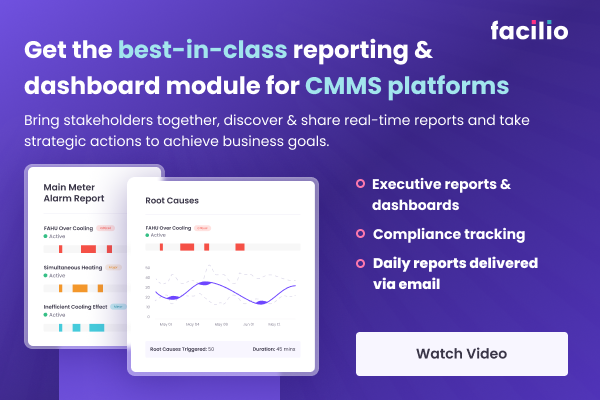
Strategic asset management (SAM) is a top-down equipment management framework for long-term maintenance and operation planning. This approach prioritizes long-term physical asset investments while balancing capital and operational expenditure from a total expenditure (TOTEX) standpoint.
An asset management strategy is a high-level, strategic plan that defines the framework for accomplishing asset management objectives in an organization. It includes asset acquisition, planning, and maintenance.
An effective asset management strategy helps asset managers optimize the value and performance of tangible and intangible assets throughout the asset lifecycle.
As a result, you can reduce asset downtime, save on repair costs, increase productivity, and boost profitability.
By the end of this article, you will learn how to develop a strategic asset management plan and ways to simplify it with a computerized maintenance management system (CMMS).
An asset management strategy helps you create a long-term asset maintenance plan which eases asset condition assessment and optimization.
The result is a better return on asset (ROA), improved decision-making, and efficient resource allocation.
The most effective way to maximize the value of production assets is to set them up for long-term success with strategic asset management.
Strategic asset management (SAM) is a top-down equipment management framework for long-term maintenance and operation planning.
This approach prioritizes long-term physical asset investments while balancing capital and operational expenditure from a total expenditure (TOTEX) standpoint.
An SAM framework provides a holistic view of current asset needs and what you’ll need 5, 10, or 20+ years down the line.
This framework gives you the data you need to make asset decisions that align with the company’s goals, instead of relying on budget and guesswork to manage assets.
According to ISO 55001, a strategic asset management plan (SAMP):
• Helps you develop asset management plans.
• Illustrates ways to convert organizational goals into asset management objectives.
• Shows ways to use an asset management system to accomplish asset management objectives.
SAM dives deep into the following areas to help you maximize the return on every dollar you spend.
Understanding the assets you own, their state, energy utilization, useful life, and whereabouts helps you create a single source of truth for all decisions.
If you’ve been using pen-and-paper inventory or spreadsheets to assign unique ID numbers and maintain asset records, it’s time to migrate to an asset management system.
An infrastructure asset management system simplifies the upkeep of asset information. Plus, it helps you form a basis for maintenance planning, resource allocation, and continuous assessment.
Assessing assets and how critical they are for smooth business operations is vital to asset management success. To rank assets, you need to answer two questions:
Set parameters to define the probability and consequences of an asset's failure. This will allow you to establish risk tolerance levels and rank assets by criticality. Also, concentrate on the most critical assets to get the most out of your investment.
Create maintenance schedules for each asset based on manufacturer recommendations, location, condition, and impact on operations.
For example, production assets running infrequently will benefit from corrective maintenance, whereas highly critical assets need total productive maintenance to stay in good shape.
Prioritize maintenance for assets based on risk, energy consumption, cost of replacement, or whichever factor matters most to you.
This eases day-to-day resource management and reliability engineering for assets. Additionally, it helps you figure out the capital budget for asset upkeep as per operation and maintenance (O&M) manuals.
Your SAMP should also include a reliability-centered maintenance process that monitors asset conditions.
ISO 55000, the international asset management standard, requires you to report on asset performance and the effectiveness of the asset management system.
The best way to meet this requirement is to leverage both reactive and proactive monitoring.
You can also use leading and lagging metrics, like energy usage per unit or labor hours per unit, to understand what needs breakdown maintenance or how to reduce failure-centric deficiencies.
SAMP is essential to determine which goals are realistic, or if you’ll have sufficient funds to maintain assets for the desired level of service.
Maintaining an asset register with asset-related transactions also helps you tackle fixed asset depreciation and asset revaluation for fiscal reporting.
Define a risk tolerance policy to measure safety and environmental risks to inform contingency plans to address specific risks.
These elements help you consistently meet service levels, manage utilities without service interruptions, and generate predictable revenues.
A good asset management strategy relies on five key pillars to boost asset productivity while minimizing asset costs.
You can leverage a CMMS to plan and automate key maintenance tasks like:
Now that you know the what, let's focus on the how.

As you build or refine your asset management strategy, use these steps to reduce expenses and maximize asset performance.
Start by understanding how your organization operates or makes investment decisions. Then, you can focus on creating asset management goals that align with business objectives. Consider presenting strategic ideas to management and staff to win their confidence and support.
Periodic asset monitoring gives you crucial data on the condition of each asset in your facility. This data tells you if the asset needs preventive maintenance to reach its expected useful life.
These asset management initiatives altogether help you create an action plan. This implementation plan must support the current business cycle.
Your asset management plan should have:
• Priority of each task, along with necessary resources.
• A timeframe for each task or improvement activity.
• Dependency on business functions or teams to complete each task.
• Consider creating a mix of short-, mid-, and long-term initiatives to ensure the availability of funds and staff for successful implementation.
With an asset management system, you can capture data about asset performance and use it to optimize investment decisions.
Progress monitoring also reveals critical areas that you should prioritize in the next enterprise asset management strategy planning cycle.
Conduct panels and focus groups with staff to hear their thoughts on existing asset management processes. This feedback lets you develop more effective solutions to meet organizational expectations.
Creating, enforcing, and m0nitoring the effectiveness of your strategic asset management plan is simple with a CMMS software.
A CMMS centralizes asset maintenance and performance data so you can easily track asset utilization, improve ROA, and stay compliant.
Modern maintenance management software like Facilio’s Connected CMMS also use IoT and machine learning to understand asset health and performance, and proactively maintain them to keep them performing at their peak, and prolong useful life.
Further, it simplifies asset condition assessment and digitizes compliance to realize improved asset value. It also gives data-driven insights for optimizing performance, health, and energy efficiency for different assets.
Overtime, using machine learning algorithms, it understands the faults and failures an asset is prone to, and determines failure modes to help you proactively tend to its maintenance needs.
The mockup shows how, by analyzing root cause of failure and automatically creating work orders, Facilio helps you eliminate unplanned equipment downtimes.
If you’d like to learn more about how Facilio’s Connected CMMS can help your organization switch from reactive to proactive maintenance, and keep your assets healthy and productive, our product experts are only a click away!

Gain portfolio-wide visibility and optimize performance of assets with data-driven insights on asset health and energy consumption.